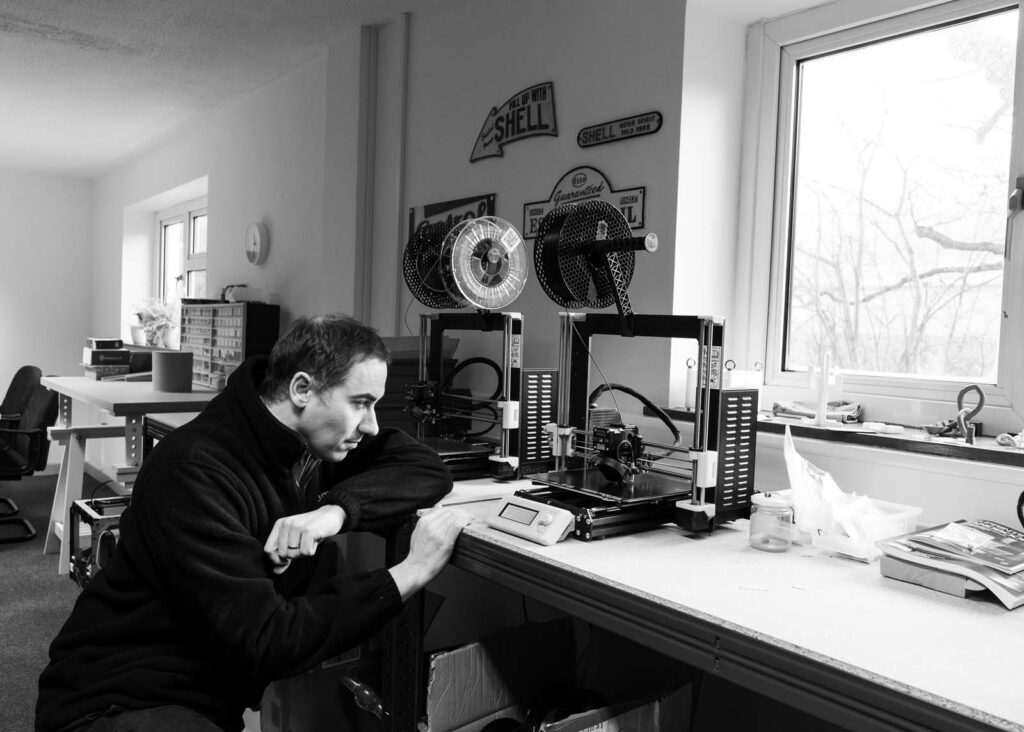The Ingram-Roots method is a sophisticated tool that offers a swift and precise means of evaluating lubricant formulations, even for those that are less experienced in Tribology.
It provides a reliable and repeatable set of results that allows different lubricants’ properties to be easily compared, so that engineers can select the most suitable lubricant for a given application.

The Ingram Roots Test Method
The test uses a MLM2 commercial sliding/rolling tribometer.
After analysis using a defined film thickness for run-in steps, to achieve test severity parity independent of viscosity, normalised Stribeck Curves are used as the main measure, by rating lubricants in terms of their relative ability to reduce friction in the main lubrication regimes.
These curves are then analysed by software to produce a rating between 1 and 10 for each of the 5 lubrication regimes:
𝑅𝑀40 – Rating at 40 °C, Mixed Regime
𝑅𝐸𝐻𝐷40 – Rating at 40 °C, EHD Regime
𝑅𝐵100 – Rating at 100 °C, Boundary Regime
𝑅𝑀100 – Rating at 100 °C, Mixed Regime
𝑅𝐸𝐻𝐷100 – Rating at 100 °C, EHD Regime
These ratings can be used to simplify the comparison of performance between lubricants, with the formulator/ engineer deciding on the most appropriate measure to use, based on the end application of the lubricant.
Download sample Ingram Roots results, including Stribeck Curves

Ingram Roots Development
To help our engineering customers more effectively evaluate lubricants’ properties, we challenged ourselves to create a simple way of presenting information about a lubricant’s performance in an easily comparable way.
Working in partnership with PCS instruments, reviewing all the current standardise methods for lubricants, then proposing a test procedure for the MTM – one we believed would be easy to use, robust and give useful data to their customers.
The final method uses a unique testing strategy – where the lubricant film thickness is kept the same – so all oils experience the same test severity, no matter what the viscosity grade is.
We liaised closely with the software team to ensure this method could be easily used by customers (lab technicians, chemists, R&D scientist etc) – requiring no complex knowledge of tribology or time to develop appropriate test methods. This test method has then been branded the “Ingram-Roots Lubricity Rating System” by the team at PCS Instruments, and is available as neat software package upgrade to all existing MTM instruments.
The approach was fine-tuned over several years and has been since demonstrated to be effective in evaluating a wide range of engine and gear oils.






“Ingram has been very flexible and helpful to adapt the analysis proceedure according to our research question.”
Fabrizio Steinebrunner, Igralub AG für Schmiertechnik
Tribological Thinking
Find out about our latest thinking, research, news and more.
-

Preparing for the summer conferences 2023
We have been busy preparing for the conferences this summer. By drafting some of our micropitting work for publication. This will be presented at STLE, Lubmat and TriboUK. We have been busy working on a rapid micropitting test that correlates to the FZG micropitting test. Our new test takes less than 40 hours and correlates…
-

Maintaining safe and quiet railways
We are currently working on an exciting project with the Railway Standards Safety Board (RSSB) and the European Lubricating Grease Institute (ELGI), to develop a new performance test for Top of rail (TOR) materials. These TOR materials are used to ensure traction and reduce noise at the wheel/rail interface. This allows trains to start without…
-

It’s Xmas Penguin Time
This year the animals at the South Pole have been having fun demonstrating the different shapes of contacting bodies.
-

Stribeck Curves
A Stribeck Curve (sometimes also called a Stribeck Friction Curve) is a common name used to described friction vs entrainment speed results, measured on a tribometer. These are very useful as they give a good overview of the frictional performance of a lubricant. The Stribeck Curve is named after the German engineer Richard Stribeck, who…
-

Covid Response 2020
At the beginning of the first COVID lockdown in the UK – March 2020, we like many other people didn’t know what effect the lockdown would have on our business. But we did know and feel like we needed to help our local community. This included the manufacture of protective face visors, using our 3D…
-

Traction Curves
Traction curves can be used to develop lubricants for specific applications, for example high traction fluids for CVTs. They can also be used to help understand the physical changes of the lubricant under high contact pressures. This can then be used to help develop new lubricants with special properties, for example with low traction to…

